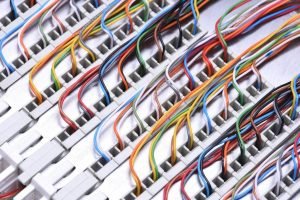Paired cables, coaxial cables and optical fiber
Normal telecommunications cables are used to transmit information as data (words, numbers, patterns, drawings, …), images and sounds that travel in the form of a signal.
In order for the information to be transmitted, these must be transformed into tracks capable of traveling along a copper cable or another type of conductor (optical fiber). The transmission can be analogue or digital. In the first case the signal is modulated ie the frequency is alternated thus changing the “meaning” of the message. In the second the signal is transmitted in binary code by means of successive pulses.
Over the years technology has gradually evolved and in the telecommunications field the construction of cables has been modified for reasons of efficiency and economy.

There are three types of telecommunications cables most known:
– cables in pairs: also called twisted pairs, they are used for computer and telephone telecommunications (LAN). The cables in pairs consist of two cores wound together in a spiral with a constant pitch. Each core is composed of a copper wire that has a diameter of a few millimeters, which is in turn covered with a plastic material (usually polythene or PVC). Depending on the uses, to avoid electromagnetic interference and to protect the cable from atmospheric agents, the twisted pair can be covered with a plastic or even reinforced sheath.
– coaxial cables: coaxial cables consist of one or more tubes joined together in a single transmission medium. This tube consists of the core (single conductor) positioned at the center of the cable, an external metal material (mesh) necessary to shield the signal and an insulating material (dielectric) that separates the core and the mesh. Coaxial cables guarantee a bandwidth and a connection speed much higher than that of paired cables
Their use in alarm and video surveillance systems is growing. This type of cables together with network cables have become indispensable for the daily work of every installer. ELAN has a wide range of coaxial cables to refer to.
From coaxial cables RG59 e RG6 chosen for satellite receivers and digital audio applications for HDTV and DTV. To micro coaxial HD and mini coaxial HD cables suitable for contexts in which space is particularly small.
– optic fiber:it consists of a very thin cable of plastic fiber or glass with a diameter of about 120 nanometers (1 mm = 1,000,000 nanometer). To cover the glass fiber cables we find two further concentric layers, the innermost buffer (bearing) and an additional external covering. The information, in this case, is made to bounce inside this very thin cable through a laser beam of light.
The optic fiber today it obviously holds the monopoly of long distance as it is able to transmit the signal for several kilometers with a very low attenuation.
